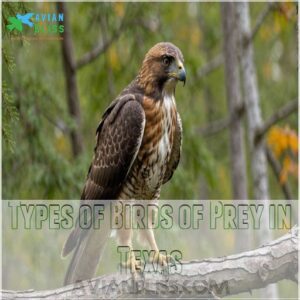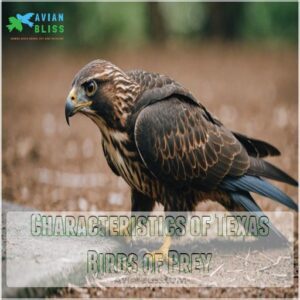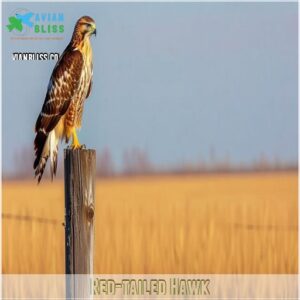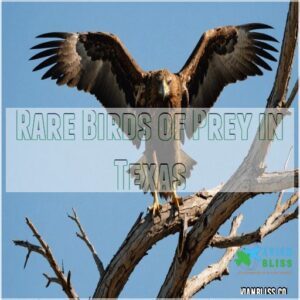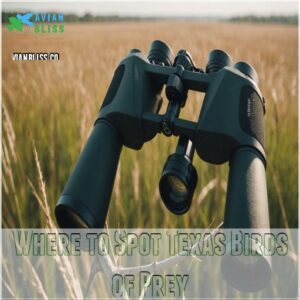This site is supported by our readers. We may earn a commission, at no cost to you, if you purchase through links.
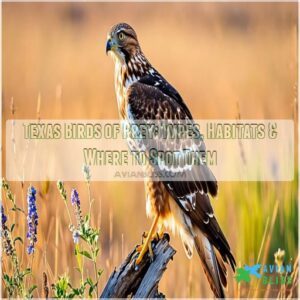 In Texas, you’re stepping into a world where birds of prey rule the skies like avian monarchs.
In Texas, you’re stepping into a world where birds of prey rule the skies like avian monarchs.
You’ll find hawks, eagles, falcons, and owls, each showcasing astounding skills in hunting.
From the iconic red-tailed hawk to the elusive Great Horned Owl, these predators adapt fantastically to different habitats, whether it’s the bustling cityscape or tranquil wetlands.
Spotting a peregrine falcon dive-bombing at 200 mph is like witnessing nature’s own action movie.
Whether you’re wandering in forests or gazing into the vast Texas sky, there’s always more to uncover about these magnificent creatures and their intriguing behaviors.
Curious yet?
Table Of Contents
- Key Takeaways
- Types of Birds of Prey in Texas
- Texas Birds of Prey Species
- Birds of Prey Habitats in Texas
- Characteristics of Texas Birds of Prey
- Common Birds of Prey in Texas
- Less Common Birds of Prey in Texas
- Rare Birds of Prey in Texas
- Where to Spot Texas Birds of Prey
- Tips for Identifying Texas Birds of Prey
- Conservation Efforts for Texas Birds of Prey
- Frequently Asked Questions (FAQs)
- What birds of prey can you see in Texas?
- How many birds of prey are there in Texas?
- What are the smallest birds of prey in Texas?
- What is a bird of prey?
- What is the common bird of prey in Texas?
- What is the most common hawk in Texas?
- What is the big GREY bird in Texas?
- What kind of hawk is grey and white in Texas?
- How do Texas birds of prey hunt?
- What do Texas raptors eat?
- When is raptor migration in Texas?
- How do raptors impact Texas ecosystems?
- Are there raptor watching tours in Texas?
- Conclusion
Key Takeaways
- You’ll find a diverse range of birds of prey in Texas, including hawks, eagles, falcons, and owls, each adapting to various environments from urban areas to wetlands.
- Red-tailed Hawks and Peregrine Falcons are among the most commonly seen raptors, known for their hunting prowess and unique adaptive skills.
- Raptors play crucial roles in Texas ecosystems by controlling rodent and insect populations, which helps maintain ecological balance.
- Conservation efforts focus on habitat preservation, ensuring these avian predators continue to thrive despite threats from development and habitat loss.
Types of Birds of Prey in Texas
When you’re exploring the skies of Texas, don’t be surprised to spot a variety of birds of prey, each with its own unique flair.
From the agile falcons zooming around like jet fighters to the solemn owls mythically watching over us, Texas offers a fascinating array of raptorial wonders to enjoy.
Hawks Found in Texas
Several hawk species call Texas home.
Red-tailed Hawks, masters of adaptation, are incredibly common, thriving in diverse habitats.
Their distinctive red tail makes identification a breeze.
Sharp-shinned Hawks, smaller and more elusive, prefer dense vegetation for ambushing prey.
Learning about Hawk Migration patterns helps in spotting these magnificent birds.
Understanding Texas Hawk Diet helps you predict their locations.
Enjoy observing these aerial acrobats—remember Hawk Conservation is key!
Falcons in Texas
Falcons in Texas are masterful predators, epitomizing agility and speed.
The Peregrine Falcon is famous for its breathtaking dives, hunting in urban areas and cliffs alike.
Falcons’ diets mainly consist of birds and small mammals.
They’re adaptable hunters, thriving in diverse habitats throughout Texas.
Conservation efforts help sustain their populations.
- Peregrine Falcon
- American Kestrel
- Prairie Falcon
- Diet: small birds, mammals
- Conservation: ongoing efforts
Eagles in Texas
Shifting from falcons, imagine spotting eagles—the mighty kings of the sky.
In Texas, Bald Eagles nest near lakes and rivers, while Golden Eagles soar in open mountains.
Their diet’s varied, favoring fish and mammals.
Migration paths weave north-south.
With conservation efforts focused on preserving habitats, you might just catch a breathtaking eagle sighting today.
| Eagle Type | Habitat | Diet |
|---|---|---|
| Bald Eagle | Lakes, Rivers | Fish |
| Golden Eagle | Mountains | Mammals |
| Conservation | Habitat Preservation | Varied Diet |
| Nesting | Coastal Areas | Fish, Rodents |
| Migration | North-South Routes | Diverse |
Vultures in Texas
In Texas, vultures are like the "cleanup crew" in the wild.
Turkey Vultures, with their fiery red faces, and Black Vultures, donned in all black, soar the skies.
Their diet? Mainly carrion, sniffed out with sharp senses.
They’re essential for ecosystems but face threats from habitat loss and poisoning.
Conservation efforts aim to protect vulture nesting sites and migration paths.
Owls in Texas
After soaring high with vultures, let’s shift to the nocturnal allure of owls in Texas.
Great Horned Owls hoot with authority, while Barred Owls watch curiously with glasses-like plumage.
Their diets vary from rodents to insects, and they nest in trees or rocky crevices.
Yet, habitat loss poses real threats.
Protecting these winged night-stalkers is essential for conservation.
Texas Birds of Prey Species
Whether you’re fascinated by the swift falcons or the majestic hawks, Texas has an impressive array of birds of prey.
Take the Red-tailed Hawk, for instance.
It spends its days gliding gracefully in the sky, showcasing its iconic red tail—an absolute Texan signature.
Peregrine Falcons, with their incredible speed, are like the sports cars of the skies, diving at breakneck speeds to snatch their next meal.
Owls, such as the Great Horned Owl, take a quieter approach, waiting for the cloak of night to catch their dinner.
These avian hunters aren’t just fascinating to watch; they play critical roles in the ecosystem.
Understanding these creatures helps in appreciating their presence and supporting Texas raptor conservation efforts.
Birds of Prey Habitats in Texas
When you’re exploring Texas, you might cross paths with birds of prey just about anywhere—from dense forests and vast grasslands to bustling urban areas and even your backyard.
These raptors are skilled at adapting to a variety of environments, though it’s probably best not to ask them about real estate advice!
Forest Habitats
Where do Texas forest birds of prey make their homes?
Many species, like the Barred Owl, thrive in the dense forest canopy, using its cover for nesting behavior.
Their prey adaptation involves stealth and surprise.
Listen closely at night—you might hear those distinctive owl calls!
Sadly, habitat threats like deforestation impact these magnificent creatures.
Grasslands and Deserts
Grasslands and deserts in Texas are bustling with bird predators.
These adaptable raptors, like the Swainson’s Hawk, thrive amid vast, arid expanses.
Desert adaptations give them an edge, allowing them to spot prey from miles away.
You’ll often witness stunning raptor migrations across these landscapes, showcasing nature’s power and resilience, though habitat threats loom large, challenging their survival.
Wetlands and Coastal Areas
While roaming the Texan grasslands, you’ll discover birds of prey thrive in wetlands and coastal areas too.
These habitats offer unique challenges, driving adaptations like keen eyesight for spotting wetland prey species.
With rich saltwater diets and particular coastal nesting sites, they ride on coastal migration patterns.
Imagine these raptors maneuvering through storms, an aerial ballet of power and precision!
Urban and Backyard Habitats
Picture your backyard as a potential haven for common birds like the American Robin and Blue Jay, which can be attracted with diverse seed mixes and shallow bird baths as explained in guides on backyard birds of Massachusetts. Picture your backyard as a potential bird feeder haven.
By learning more about the different raptors in Texas, you can create a haven that will attract these magnificent birds of prey.
Urban adaptations help birds of prey thrive in cities.
However, backyard dangers like habitat loss can be a challenge.
To attract these magnificent raptors, consider:
- Installing nest boxes
- Maintaining tall trees
- Providing water sources
- Avoiding pesticides
- Offering places to perch
You’ll be amazed by your new feathered neighbors!
Characteristics of Texas Birds of Prey
You’ll notice that Texas birds of prey, from the speedy Peregrine Falcon to the mighty Bald Eagle, come in all shapes and sizes, sporting unique plumage and colors that would make even a peacock blush.
They’ve got specialized beaks and impressive hunting techniques, proving that nature designed them as the ultimate aerial predators, kind of like the jet fighters of the bird world.
Size and Shape
When you’re spotting Texas’s birds of prey, pay attention to size and shape.
From the majestic wingspan of the Bald Eagle, which is rivaled by the impressive 7-foot wingspan of the large bird of prey with a brownish yellow neck like the Golden Eagle, to the compact body length of the American Kestrel, these features are key identifiers.
Talon size and head shape hint at their hunting prowess, while beak size varies, giving each raptor a distinct silhouette, adding personality to their flight.
Plumage and Coloration
Texas birds of prey are like nature’s fashionistas.
Their plumage variations offer clues about their lifestyle and environment.
1. Seasonal changes can alter patterns, making identification a fun challenge.
2. Coloration patterns help with camouflage, letting hawks and owls sneak up on their meals.
Look closely at those feathers; they’re not just for flight but a masterpiece of nature’s artistry!
Beak Shape and Size
Notice how a bird’s plumage affects its camouflage.
Now, let’s look at their beaks.
Beak shape and size are directly linked to diet.
A hawk’s strong beak easily tears flesh, while a smaller bird’s beak is better for picking seeds.
Beak adaptations reflect millions of years of evolution.
Understanding a bird’s beak function, like how specific bird beak products, can also help us better appreciate their roles in the ecosystem.
Check out these examples:
| Bird Type | Beak Shape | Beak Size | Prey Size | Diet Variation |
|---|---|---|---|---|
| Red-tailed Hawk | Hooked, sharp | Large | Small to medium mammals | Carnivorous |
| American Kestrel | Hooked, pointed | Small | Insects, small rodents | Insectivorous/Carnivorous |
| Turkey Vulture | Hooked, slightly weak | Medium | Carrion | Scavenger |
| Great Horned Owl | Hooked, powerful | Large | Small to large mammals | Carnivorous |
| Barred Owl | Hooked, strong | Medium | Small mammals, rodents | Carnivorous |
Beak function is key to understanding a bird’s survival strategy.
Hunting Styles
In the thrilling world of Texas birds of prey, hunting styles are as diverse and fascinating as a kaleidoscope of strategies.
From aerial ambushes like raptor dives to the perch and pounce tactics of hawks, each technique showcases its adaptability.
Meanwhile, kestrels exhibit hovering hunts, demonstrating precision.
Even cooperative hunting among eagles illustrates teamwork, blending cunning with nature’s drama.
Common Birds of Prey in Texas
When you’re exploring the skies of Texas, you’ll often spot the common Red-tailed Hawks, American Kestrels, Bald Eagles, and Turkey Vultures soaring above.
These raptors are impressive in their hunting skills but also quite accommodating if your main goal is ticking them off your bird-watching list.
Red-tailed Hawk
Spot a Red-tailed Hawk and you’re gazing at one of Texas’s most adaptable raptors.
With calls that echo like a Western movie and a diet full of rodents, it’s a wildlife watcher’s delight.
Here’s what to track:
- Nesting: Look high in trees.
- Habitat: Diverse, from parks to forests.
- Threats: Human activity impacts.
- Conservation: Efforts ongoing statewide.
American Kestrel
The American Kestrel, a pint-sized raptor, boasts vibrant plumage and acrobatic hunting skills.
It hovers gracefully, like a miniature helicopter, before diving for prey.
With its shrill calls echoing through open fields, this bird’s diet mainly consists of insects and small rodents.
Though thriving, it faces threats from habitat loss.
Here’s a quick comparison:
| Aspect | Details |
|---|---|
| Hunting Style | Hovering dives |
| Diet | Insects, rodents |
| Threats | Habitat loss |
Bald Eagle
After watching the nimble American Kestrel, you’ll be amazed by the majestic Bald Eagle, a symbol of power and grace in Texas, with a wingspan of up to 92 inches, making it North America’s largest bird of prey. Keep an eye out for these icons near lakes and rivers.
- Bald Eagle Diet: Primarily fish, plus some small animals.
- Bald Eagle Nesting: Huge treetop nests, often reused yearly.
- Bald Eagle Conservation: Protected to prevent extinction.
Turkey Vulture
You’ve probably seen Turkey Vultures gliding effortlessly in the Texas sky.
Known for their keen sense of smell, they can sniff out carrion from miles away—a scavenging superpower!
Their diet revolves around dead animals, which they consume with gusto.
Nesting habits? Simple ground scrapes.
Ever noticed their flight patterns? Graceful, riding thermals like nature’s cleanup crew.
Less Common Birds of Prey in Texas
While you’ll often spot red-tailed hawks and bald eagles, Texas also harbors some less common raptors like the elusive Broad-winged Hawk or the speedy Peregrine Falcon, making birdwatching a thrilling game of chance!
Keep your eyes peeled for these more secretive birds of prey, and you might just be rewarded with a rare sighting.
Broad-winged Hawk
Broad-winged Hawks, those secretive forest dwellers, grace Texas each spring.
Here’s why they’re special:
- Migration Patterns: Marvel at their epic journey to South America.
- Breeding Habits: Nest in woodlands, hidden from prying eyes.
- Diet: Feast on insects, frogs, and small mammals.
- Threats: Habitat loss challenges their serene lifestyle.
Spotting them is like finding a treasure!
Sharp-shinned Hawk
The Sharp-shinned Hawk, smaller than its Broad-winged cousin, zips through mixed forests in Texas.
Imagine a feathered ninja, quietly perched, keenly watching for prey.
Notoriously elusive, this hawk loves dense woods.
| Feature | Detail | Importance |
|---|---|---|
| Diet | Small birds and mammals | Sustains energy, growth |
| Nesting | Coniferous trees | Safe rearing of young |
| Migration | Autumn and spring | Follows prey and climate shifts |
Osprey
Ospreys, often dubbed the "fish hawks," have a particular fondness for seafood, making their homes near Texas lakes and rivers.
Their powerful talons snag fish with precision, while their impressive wingspan aids long migrations.
Keep an eye out for these distinctive raptors.
- Fish diet: Specialize in catching fish.
- Nesting habits: Prefer tall structures near water.
- Migration patterns: Travel vast distances yearly.
Peregrine Falcon
You might spot a Peregrine Falcon zooming through the Texas sky.
Known for their lightning-fast dives, reaching speeds up to 240 mph, they’re often seen on urban nesting sites.
These city dwellers have adapted brilliantly, hunting pigeons and other birds with unmatched precision.
Their urban adaptations showcase nature’s cleverness.
Want to spot one? Look up!
| Characteristic | Description | Example Locations |
|---|---|---|
| Speed | Up to 240 mph | Skydiving dives |
| Nesting Sites | Tall buildings | City skyscrapers |
| Adaptations | Urban environments | Bridges and towers |
| Hunting Techniques | Aerial pursuit | High-speed chases |
Rare Birds of Prey in Texas
Spotting a rare bird of prey in Texas can feel like finding a needle in a haystack, but it’s always worth the effort.
Imagine the thrill of glimpsing a golden eagle or a northern saw-whet owl, each boasting distinctive traits that make them unique delights on your birdwatching checklist.
Golden Eagle
Spotting a Golden Eagle in Texas is like witnessing a scene from a wildlife documentary.
These majestic birds, skilled in flight and fierce hunters, typically favor mountainous regions.
Here’s what to know:
- Diet: Mostly mammals, often larger than themselves.
- Nesting: High cliffs or tall trees.
- Flight: Soaring with wings wide and steady.
- Threats: Habitat destruction and human interference.
Great Horned Owl
Where do you find these magnificent creatures?
Great Horned Owls, Texas’s resident giants, inhabit diverse woodlands and can be supported by purchasing products from online stores like Great Horned Owl Texas products.
In Virginia, the Great Horned Owl’s haunting calls are often accompanied by those of the Eastern Screech-Owl whinny calls. Their haunting Great Horned Owl calls echo at night.
These owls are apex predators, with a varied diet and impressive nesting habits.
Sadly, habitat loss threatens their Conservation Status.
Protecting their territories is key to their survival.
Let’s work together to make sure these majestic birds thrive.
Barred Owl
Great Horned Owls may rule the night, but the Bald Eagle’s recovery from DDT ban is also a notable conservation success, as seen in large birds in Virginia. Barred Owls add their unique charm with those haunting calls echoing through Texas woodlands.
You’ll recognize them by their horizontal stripes and curious nature—often staring back as you pass by.
These birds prefer dense forests, feeding on small mammals.
While common, they’re still a sight to cherish deep in those eastern forests.
Northern Saw-whet Owl
After marveling at the Barred Owl’s watchful nature, you’re in for another treat with the Northern Saw-whet Owl.
These tiny nocturnal raptors, with their big eyes and surprising bravery, charm birdwatchers.
Rare in Texas, they’re best spotted during winter migration.
Listen closely—its tooting vocalizations are like a truck backing up, signaling their presence.
Conservation threats loom, so spotting one is a privilege.
Where to Spot Texas Birds of Prey
You can spot Texas birds of prey in a variety of places, from national parks and state forests to your own backyard or urban areas.
Just keep your eyes peeled during a birding tour or festival, and you might catch a Peregrine Falcon racing by or a Bald Eagle showing off its impressive wingspan—binoculars not required but definitely recommended!
National Parks and Wildlife Refuges
National parks and wildlife refuges in Texas offer a haven for unique species and raptor populations, much like the diverse array of raptors thriving in the Sonoran Desert, where Harris’s Hawks hunt cooperatively.
Visit these spots for a thrilling birding adventure:
- Big Bend National Park: Home to various raptors.
- Laguna Atascosa National Wildlife Refuge: Known for its diverse avian life.
- Aransas National Wildlife Refuge: Spot rare birds.
- Santa Ana National Wildlife Refuge: A must-visit for enthusiasts.
State Parks and Forests
You’ll frequently find amazing opportunities to observe Texas birds of prey in state parks and forests.
These areas offer diverse habitats where raptors thrive.
Here’s a quick guide:
| Location | Bird Species |
|---|---|
| Big Bend State Park | Golden Eagles |
| Bastrop State Park | Red-tailed Hawks |
| Huntsville State Park | Barred Owls |
| McKinney Falls | Cooper’s Hawks, a medium-sized bird of prey with a wingspan of up to 28 inches, are known for their impressive stealth hunting techniques. Cooper’s Hawks |
| Lost Maples SP | American Kestrels |
Explore these spots for a birdwatching adventure!
Backyard and Urban Areas
Ever wonder what draws birds of prey to urban and backyard settings?
It’s fascinating how Red-tailed Hawks and American Kestrels adapt to city life.
You might spot them perched on rooftops or in local parks.
With a backyard feeder, you can attract smaller raptors while also ensuring their safety.
Keep an eye out for common sightings and enjoy their majestic presence!
Birding Tours and Festivals
Texas birding enthusiasts’ options abound!
To increase chances of spotting owls, timing is crucial, with the best time to look for owls often occurring at dusk and just before dawn. Guided tours offer expert insights into prime viewing spots, while festivals showcase incredible bird diversity.
Learn photography tips from seasoned pros.
Remember ethical birding practices—respect wildlife and their habitats.
Discover Texas birding hotspots and festival highlights—an unforgettable experience awaits.
Tips for Identifying Texas Birds of Prey
When you’re out watching the skies in Texas, spotting a bird of prey means looking for clues like size, shape, and behavioral quirks—kind of like a natural version of "I Spy".
Keep an eye out for distinct plumage patterns and favorite habitats, and you might just become the Sherlock Holmes of birdwatching!
Size, Shape, and Structure
Spotting Texas birds of prey is like finding treasure.
Their unique size, shape, and structure set them apart.
Here’s what to look for:
- Wingspan: Larger wings mean they’re built for soaring.
- Body Length: Longer bodies often indicate graceful gliders.
- Talon Size: Big talons signal a fierce hunter.
- Beak Shape: Hooked beaks are made for tearing.
- Feather Patterns: Unique textures provide camouflage.
Engage your curiosity and power of observation!
Plumage and Coloration Patterns
Birds of prey in Texas flaunt unique plumage variations and coloration adaptations, essential for survival.
Spot their camouflage techniques, as feathers blend into surroundings, like a master of disguise.
Seasonal changes mean colors might shift.
Observe flight patterns and identify them soaring, often with a touch of humor by how they mimic superheroes on a secret mission.
| Feature | Description |
|---|---|
| Plumage variations | Feathers with diverse colors and patterns |
| Coloration adaptations | Help them blend into surroundings |
| Camouflage techniques | Aid in stealth and surprise attacks |
| Seasonal changes | Alter plumage color for different seasons |
| Flight patterns | Unique soaring and diving styles |
Habitat and Behavior
When identifying birds of prey, think about their surroundings and behaviors.
These raptors have varied homes and habits.
Consider their:
- Nesting sites, often high and hidden.
- Diet preferences, like rodents or fish.
- Migration patterns, hinting at seasonal sightings.
- Social behavior, some being loners, others sociable.
It’s like a wildlife detective game—observe, note, identify!
Conservation Efforts for Texas Birds of Prey
You’ve probably heard of habitat preservation and hunting regulations, but did you know they play a big role in protecting birds of prey in Texas?
By understanding research and participating in education programs, you can help guarantee our skies remain filled with majestic raptors—plus, it makes for great party talk when you spot a hawk from your backyard!
Habitat Preservation
Protecting Texas birds’ homes is essential.
Habitat loss is a major threat, impacting everything from nesting sites to food sources, especially for species like the Crested Caracara nesting sites.
We can all help!
| Action | Benefit |
|---|---|
| Support land conservation | Protects essential habitats |
| Restore degraded areas | Creates new homes for birds |
| Participate in citizen science | Helps track populations and threats |
Land use changes and development put pressure on these magnificent creatures, so responsible land management is key.
Small actions make a big difference.
Hunting Regulations
Understanding the hunting regulations for Texas birds of prey is like deciphering a treasure map. You’ll find:
- Hunting seasons: strictly defined, ensuring species protection.
- Permit requirements: a must for any legal hunting, which can be obtained through a Texas Hunting License.
- Ethical hunting: promotes sustainable practices.
- Legal limits: prevent over-harvesting.
Getting it right means balancing freedom and responsibility for conservation efforts.
Research and Monitoring
Hunting regulations set the stage for ongoing research and monitoring of birds of prey in Texas.
Join citizen science projects that track population trends and explore habitat mapping.
Get your hands dirty with radio telemetry or genetic analysis, painting a clear picture of these majestic creatures.
It’s a rewarding way to better understand and protect them.
Education and Outreach
While research and monitoring are essential, engaging with the public is where education and outreach shine.
Joining bird watching clubs and participating in citizen science projects lets you get fully involved in raptor conservation personally.
Education programs boost public awareness, turning bird enthusiasts into ambassadors for these fascinating creatures.
Sharing stories over coffee could save the next generation of winged wonders!
Frequently Asked Questions (FAQs)
What birds of prey can you see in Texas?
Texas boasts a diverse raptor population! You’ll spot Red-tailed Hawks, American Kestrels, and Bald Eagles frequently. Less common are Peregrine Falcons and even Golden Eagles. Keep your eyes peeled!
How many birds of prey are there in Texas?
In Texas, you’ve got about 30 species of birds of prey to admire, ranging from mighty eagles to speedy falcons.
These raptors dominate the skies and are fascinating to watch, whether you’re in urban areas or wild terrains.
What are the smallest birds of prey in Texas?
American Kestrels and Sharp-shinned Hawks hold the title for the smallest birds of prey in Texas.
These tiny raptors impress with their agility and speed, tackling prey with precision that’s anything but miniature.
What is a bird of prey?
Imagine a pilot of the sky, hunting with precision and power.
A bird of prey, like this, thrives by feeding on other animals, boasting sharp talons and keen eyesight.
These aerial hunters command the skies dominantly.
What is the common bird of prey in Texas?
Red-tailed Hawks, which thrive in various habitats from pastures to woodlands, often seen in suburban backyards, similar to their presence in Georgia. Red-tailed Hawks are common birds of prey in Texas.
They’re easy to spot with their soaring flight and distinctive red tails.
These adaptable hunters are present year-round in diverse habitats, from urban areas to forests.
What is the most common hawk in Texas?
Imagine this: You’re driving through Texas, and a hawk suddenly glides above—a Red-tailed Hawk, the most common hawk here.
Admire its rusty-red tail and how it gracefully navigates diverse landscapes, from urban spots to forests.
What is the big GREY bird in Texas?
That’s a tough one without more details! Several Texas birds are grey. Could you describe its size, location, or any other features? That’ll help narrow it down.
What kind of hawk is grey and white in Texas?
Imagine a hawk dressed in a dapper suit of grey and white; you’re likely spotting a Northern Harrier.
These elegant birds glide low over fields and marshes in Texas, their striking plumage making them stand out.
How do Texas birds of prey hunt?
Texas birds of prey use keen vision and stealth to hunt.
Hawks and eagles soar high, spotting prey from afar, then dive rapidly.
Owls silently glide through the night, relying on acute hearing.
Skillful, yet adaptable hunters!
What do Texas raptors eat?
Picture a buffet for raptors in Texas: they feast on rodents, snakes, birds, and insects.
Some, like the Osprey, prefer fish, diving swiftly to catch their meal.
These predators adapt their diet to available prey.
When is raptor migration in Texas?
Raptor migration in Texas peaks during spring and fall.
You can witness Broad-winged Hawks and Swainson’s Hawks making the journey between their breeding grounds in North America and wintering areas in Central and South America.
How do raptors impact Texas ecosystems?
Ever wondered how raptors shape ecosystems?
These birds of prey keep the balance by controlling populations of rodents and insects.
Their nesting habits also foster biodiversity, creating habitats for smaller creatures.
Raptors are nature’s skilled pest control.
Are there raptor watching tours in Texas?
In Texas, you can find guided raptor watching tours that offer a chance to see diverse birds of prey in their natural habitats.
Organizations and local birding groups often host these tours, providing educational experiences.
Conclusion
So, you’ve journeyed through the incredible world of Texas birds of prey!
From the majestic bald eagle to the stealthy great horned owl, you’ve discovered a fascinating array of avian hunters.
Remember, these magnificent creatures aren’t just pretty faces; they’re essential parts of Texas’ ecosystems.
Protecting their habitats is key to ensuring their survival.
Next time you’re outside, keep an eye out—you might spot a red-tailed hawk soaring overhead!
Learning about Texas birds of prey is an adventure in itself; continue exploring these incredible animals and their role in the state’s biodiversity.
Happy birding!

